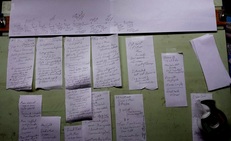
Revision is a process that I imagine every writer tackles in his or her own way. Of course there are those magnificent geniuses in movies who type the last word, then dramatically pull the paper from the printer and say, “Done!” Not in the real world. I’d be willing to bet they don’t even do that in a writer’s room where several talented heads get together on the same project.
Some authors I’ve spoken with on the subject don’t begin revisions until they get the entire first draft on paper. Some work on a few chapters, run them through their critique process and get busy re-doing right away. Then they repeat the process with each new chunk of material. And there are about a thousand levels between. I know a young adult author who writes in rhyme – a whole novel, that is. She actually did say, “When it’s done, it’s done.” Her editor doesn’t even force the rewrites. But she completed the process along the way, so in fact, she did revise and plug her holes.
A few days ago I started thinking about where my latest WIP was going. I’m still somewhat of a newbie, but I’ve been picking up techniques and tools along the way. I’m not quite finished with this mid-grade horse story, but I’m worried about all my points coming together. And I don’t want to waste weeks of writing and critiquing just to turn around and redo because I missed an important piece of a plot. So I pulled out the toolbox and started digging.
My first and favorite tool is an outline. The beginning chapters are done loosely while the outline is coming together. I have a firm idea of the opening scene and the closing scene and some big plot points along the way. But a really good story often writes itself once it gets going, so I steam away and tighten up my outline as I go.
Outlining works for me because I have the story all on one page. More important, I keep track of the plot. I do have to go back and work on character building and scene painting, but without a strong plot, who cares. I can also see sub-plots and plot twists emerging as my outline develops. And I can keep track of major changes I have made or need to make. Now the work is getting fun. Still hard work and a challenge, but it’s exciting to see it come together.
My second favorite tool is my spiral. Maybe I should clarify. It should be a spiral that I carry around with me to jot down notes and ideas, but really it’s a collection of scribbles on the backs of envelopes, old receipts, napkins, and anything else I can find to write on when the Muse drops a word on me. Basically, keep track of every idea. I have a good friend who relies on sticky notes. I think she the sticky-note people in business all by herself. But it works for her. Every intriguing new sentence, character trait, action, or scene idea goes down on paper – or my little voice recorder on my phone – to be incorporated in my story when I get back to the keyboard.
Of course I print hard copies and take them to a neutral corner and read. I’m not sure why, but mistakes just pop out on paper, but lie hidden on the screen. And since it’s nearly Arbor Day, I sorta feel guilty for killing trees. But I do recycle, and I plant trees, too.
For revision and all the other skills needed to bring an idea into a great book, I look to the professionals who’ve been there and written about it. I figure if their books are still in print after a few years, they must have something good going on. Some of the plans in the vast ocean of writing craft manuals simply don’t work for me, or it’s the same thing said in a different color (but it’s still a rose). I do use a few which I found by googling a keyword. So the one I’m using today to find and patch holes in my plot is a story development and revision worksheet that can be found online at jamigold.com.
The worksheet asks a series of questions for a character driven plot and the first time I looked at this, months ago, I couldn’t even begin to answer them. What moral choice did my character have to make? No clue. What were her external and internal goals? I only thought I knew. Write a few more chapters and revisit.
So, now that I’m within sight of the ending scene, the answers to these questions are much clearer. And they show the gaping, bleeding holes in my plot. I also see that there are several characters in my story who need to arc and so they also need action, character building, and great scenery to bring them out. Now I’m ready to answer these questions for all my characters. And I discover I have a main plot, two sub-plots, and a great plot twist. I’ve also tagged all my characters with an arch-type, but that’s a different story.
Giving all credit to Jami Gold, who incidentally writes paranormal and I wouldn’t even try to do such a thing, here are the questions I had to answer about the arcing characters of my story:
How will the protag change? How does the struggle to complete the action affect the character?
What moral choice will the protag have to make?
What does the character learn about him or herself?
What external goal does the character want to reach? (here’s some action)
What’s holding the character back?
What does the character have to overcome?
Next: How does the plot reflect the character’s struggles?
What initial problem grows out of the character’s weakness?
What opponent is competing for the same goal? (Here’s where I found the sub-plots and juicy plot twists)
What’s the characters plan?
What immoral act does the character do as a result of his/her weakness?
What’s the criticism or justifications for the choice?
What’s the final battle? (Is there really a final battle for every character who needs to come to grips with a problem they may have with the protagonist?) That was fun to discover.
What is the character’s new self?
The list goes on, and of course there is a great lesson to go along with it. I have spent the last two days working through this, story-boarding, jotting down notes, and adding text in red to my outline (meaning that’s the stuff I need to work on)
My little heart went pitty-pat when I found all the holes in my plot which needed to be patched and I simply had to share. I encourage you to visit jamigold.com. It’s simply another great tool to add to the toolbox.
I’d love to hear how you wrap up your plots and character arcs.

 RSS Feed
RSS Feed
